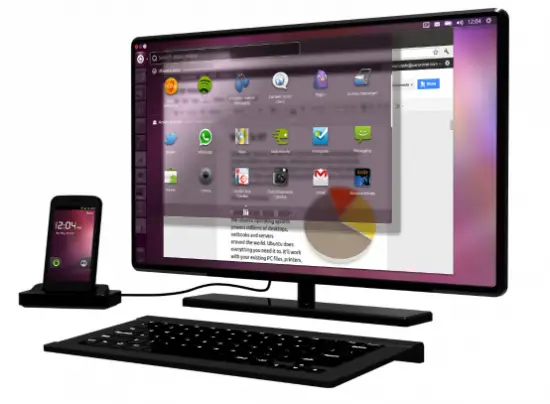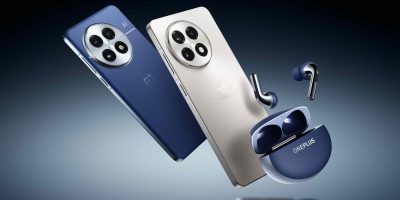
Your Android phone is about to get a lot more powerful thanks to Canonical. Today it was announced that the company will be bringing the full Ubuntu desktop to Android devices with the muscle to run it. We’re not talking some watered-down installation of Ubuntu running via some emulator, either. Ubuntu for Android will run simultaneously alongside Google’s mobile platform and launches when the phone is connected to a computer screen.
Data is share between the two operating systems allowing for seamless movement between an Android mobile device and the Ubuntu desktop. You’ll get everything from Ubuntu TV to desktop web browsing and Ubuntu apps. Specifics on hardware haven’t been divulged, but the desktop OS will run on multi-core devices featuring both HDMI and USB ports, at the least.
The announcement echoes a trend towards unifying computing devices such as the smartphone and a desktop PC. Motorola has been steadily improving their WebTop experience for their high-end smartphones, which brings a more rich computing experience when the device is docked. It is also said that Google is building in desktop elements to the next iteration of Android, Jelly Bean. Canonical will be showing off their spin on the concept at Mobile World Congress next week and you best believe we’re itching to try it out. We’ll have a full report then.
Ubuntu for Android at MWC – world’s first full-featured desktop on a docked smartphone
Carry less, do a lot more. All the productivity and apps of the full Ubuntu desktop, built into your Android phone.
London, 22nd February, 2012: Canonical today unveiled Ubuntu for Android, bringing the world’s favourite free desktop experience to multi-core Android smartphones docked with a keyboard and monitor. Use Android on the phone and Ubuntu as your desktop, both running simultaneously on the same device, with seamless sharing of contacts, messages and other common services.
The phone experience is pure Android – it’s a normal Android phone. When the device is connected to a computer screen, however, it launches a full Ubuntu desktop on the computer display. It’s exactly the same desktop used by millions of enterprise and home users on their Ubuntu PCs, and includes hundreds of certified applications, from office productivity to photography, video and music.
All data and services are shared between the Ubuntu and Android environments, which run simultaneously on the device. So Android applications such as contacts, telephony and SMS/MMS messaging are accessible from the Ubuntu interface. Indeed, all data on the smartphone can be accessed at any time, docked or not.
Ubuntu for Android gives mobile workers a company phone that is also their enterprise desktop. Government and private institutions have embraced Ubuntu on the desktop because of its ease of use, security, manageability, superb range of native applications and excellent support for web browsers like Chrome and Firefox. The desktop can also include Windows applications, using thin client and desktop virtualisation tools. Today’s IT departments commonly support a PC and at least one desktop phone for every employee. Many also provide and manage mobile phones. Ubuntu for Android presents a compelling solution to IT complexity by reducing that burden to a single device.
The first PC for the next billion knowledge workers could be a phone – but they won’t just want to use it as a handset. They will want all the flexibility and productivity of a full desktop, as well as the convenience of a smartphone on the move. Ubuntu for Android represents the first opportunity for handset makers and network operators to address this growth opportunity in emerging markets.
“The desktop is the killer-app for quad-core phones in 2012” says Mark Shuttleworth. “Ubuntu for Android transforms your high-end phone into your productive desktop, whenever you need it”
Manufacturers targeting the corporate phone, as well as the next-generation enterprise desktop and thin clients can easily add Ubuntu for Android to their smartphones. The customized version of Ubuntu drops in cleanly alongside the rest of Android, and the necessary Android modifications are designed for easy integration. Hardware requirements include support for HDMI and USB, standard features in high-end handsets planned for late 2012.
Ubuntu for Android justifies the cost to enterprise customers of upgrading to higher bandwidth 4G connections and contracts. Cloud apps like Google Docs work best with a full desktop, and shine with the lower latency of LTE. Network operators can deliver their own branded applications and services as part of the Ubuntu desktop, in partnership with Canonical.
Canonical leads the traditional Linux ecosystem in support for the ARM architecture, having co-founded Linaro (linaro.org), the consortium dedicated to the unification of Linux on ARM and the simplification of Android integration and delivery. That industrial experience, combined with Canonical’s long-standing leadership in desktop Linux and deep relationships with global PC brands enables Canonical to deliver an ARM-optimised desktop tightly integrated with Android, on silicon from a range of ARM vendors.
Useful Links and Contacts
Product information and specifications at www.ubuntu.com/devices/android
Contact us to bring Ubuntu for Android to market: www.ubuntu.com/devices/android/contact-us










That’s great – I’ve been running Ubuntu on my Evo 3D for months.
http://androidforums.com/evo-3d-all-things-root/387978-ubuntu-linux-3vo.html
Very handy – this new development should make the process easier for others, fewer installation hassles.
I’ve had Ubuntu running on my HTC Desire for ages too…Hopefully by the time I upgrade to a quad-core this will make it a nicer experience!
This is a great idea that could be implemented very, very poorly. We’ll have to wait and see.
yep. It’s early, has potential, but also unity is the worst linux UI I’ve ever seen. Why wasn’t this redhat or something else that isnt’ horrible?
Since they claim that Android apps can be run from the Ubuntu interface, I am curious to see if, for the first time, Netflix (via the android app) can be used properly on a Linux desktop (even if that desktop is your phone).
Not all, some:
“So Android applications such as contacts, telephony and SMS/MMS messaging are accessible from the Ubuntu interface.”
The picture clearly shows many other Android apps like Kindle, Spotify, Maps, Foursquare, etc. Now, who knows if it will actually end up working, but I have no reason to believe only the apps like “contacts, telephony and SMS/MMS” will be available.
Just because it shows the apps, doesn’t mean it will be compatible. Sorry.
Given the information we have currently at our disposal, it appears more likely they will be then they won’t be. Could the graphic be wrong? Sure. But what reason do you have to suggest they won’t be? Webtop already does it (albeit poorly) and Webtop is based on Ubuntu.
If the phone uses a MHL connector (HDMI), you could just output the Netflix and other video apps to the monitor using the standard interface — there’d be no need to run them through Ubuntu first… What would be the point?
(this is meant as a reply to James Myers… silly disqus)
Is this kind of beat Winders 8 to the draw kind of thing ?
I like it , can’t wait .
This sounds great and I’d use it. But a Linux GUI desktop takes up a lot of storage. Seems like it could eat up a 32Gb phone/tablet quickly.
I run Ubuntu on my phone with the LXDE (lightweight X desktop environment) – my entire Ubuntu image is just over 2 GB, with Open Office and Gimp installed – fwiw.
I have Ubuntu installed on my CR48 right not. It’s my main computer. This has a 16GB SSD. It only uses between 3 and 4.
No. A full usable Ubuntu Linux install can fit into about 2-3GB.
Little disappointed, was hoping I was gonna be able to switch over to “ubuntu mode” on my Xoom. Xoom screen is big enough for me and I already have mouse and keyboard support on it.
Come on Asus. Here’s to hoping the next Transformer supports this for docking to the keyboard dock.
I hope they patent the ability to use a phone in a lap dock like device and desk top dock. Serious leg up on apple imho.
Unfortunately Motorola has beat them to it. Their Lapdock products all run a variant of linux with similar function.
Why always Ubuntu POS, why is never a decent distro (OpenSuse, Mageia/Mandriva, even Fedora).
Fail for me until a proper distro is used, but it’s a great early step, IF it works.
Its because Canonical is very active into development. They don’t share back to the community as much as I’d like them to, but they’re disto’s have historically been more polished than any other (I’ve used just about all and support Linux at my company). Post 11.04…meh. Not so much. Server 10.04 is pretty sweet for EC2 deploys.
This is an effort by Canonical, not some open-source offshoot. You may be waiting a while for OpenSuse. Mandriva…..aren’t the bankrupt yet? I was a big Mandrake user, moved to Mandriva and saw their stability die after. PLF was the best URPMI repo.
Fedora is good now. Historically, rpm repo’s are a pain. Yum is slow and plays poorly with proxies. I’m actually looking at Fedora a bit closer and are one to watch. More likely see a RedHat/Android app in the market. Branding thing.
I really hope Canonical pushes what they do to open-source then you can choose. It would be pretty sweet I guess.
I want to see Ubuntu’s soft keyboard really improve. My friend at work dual boots his Transformer into Ubuntu. Its only usable with hardware keyboard or dock.
This is what i’ve been waiting for. I hope this is better.